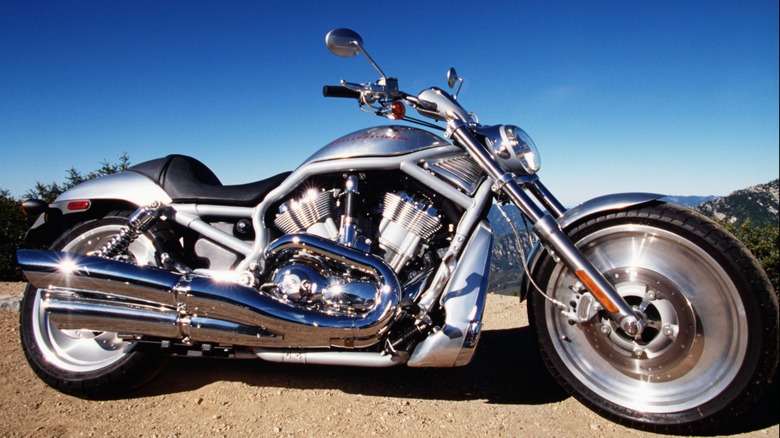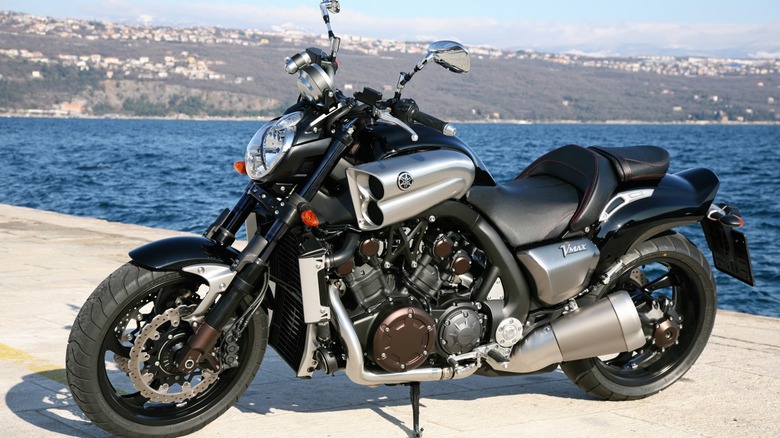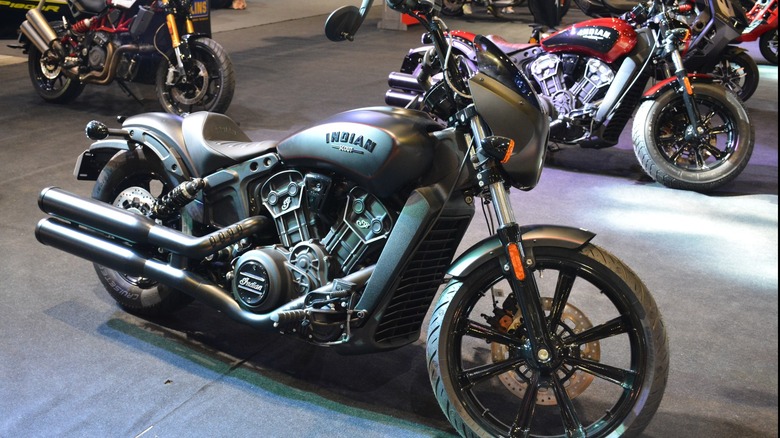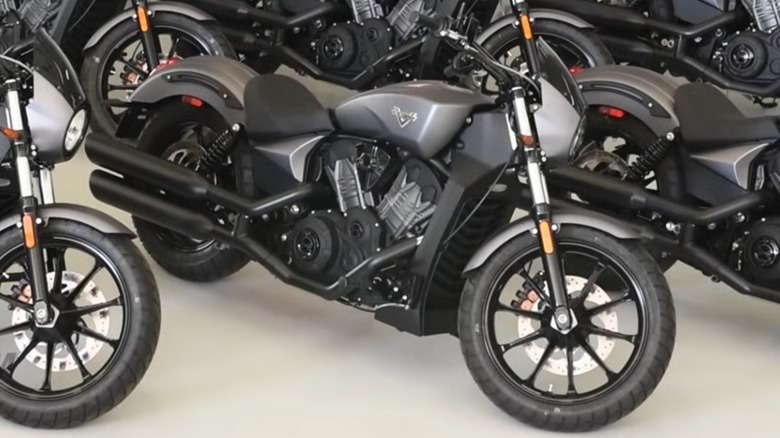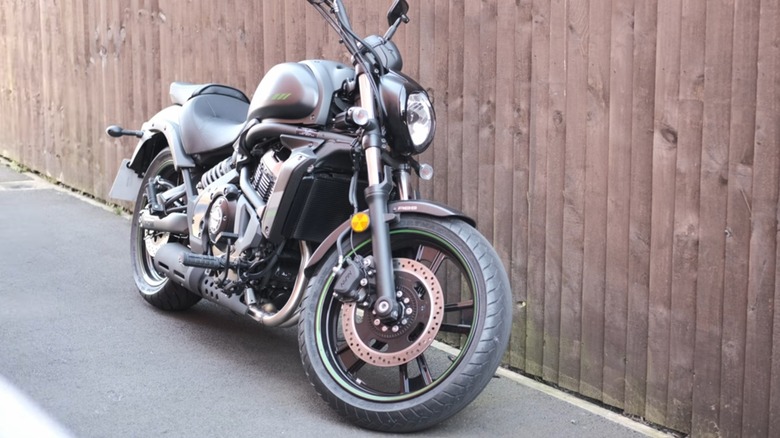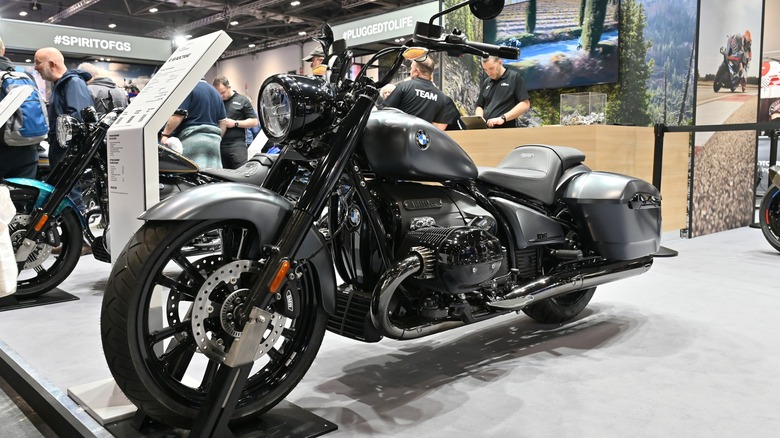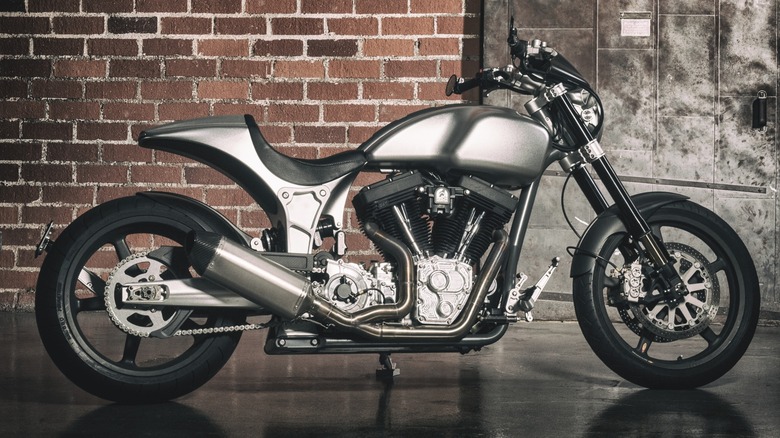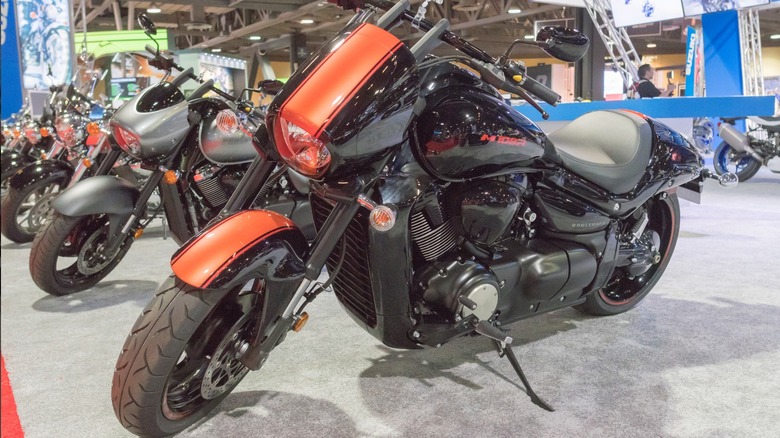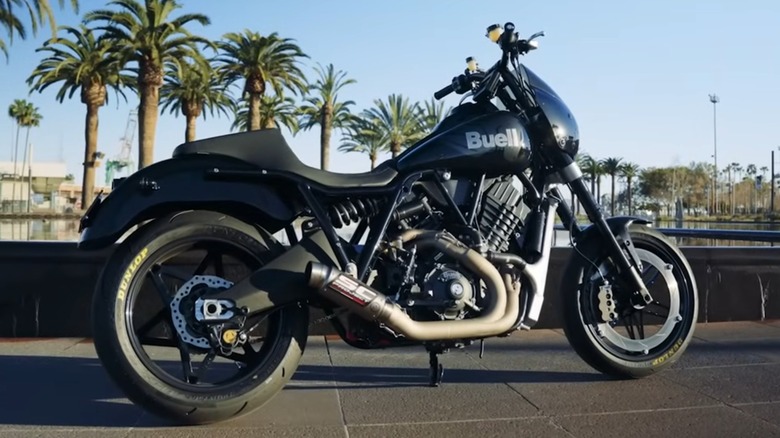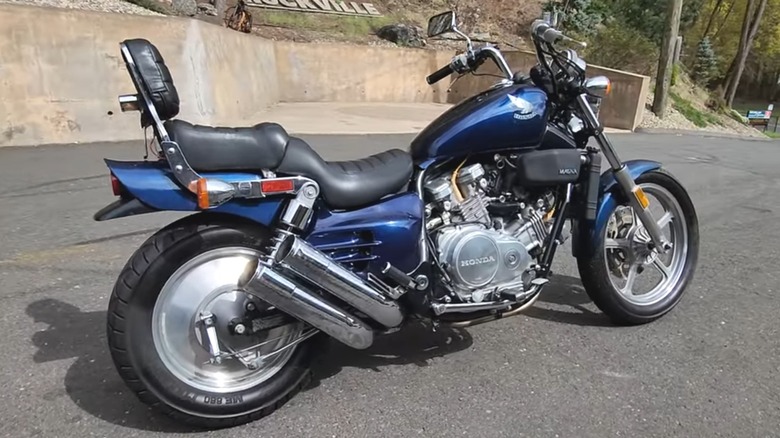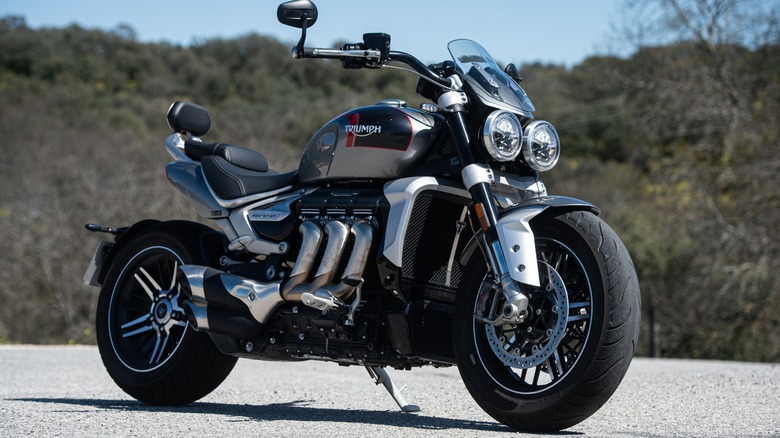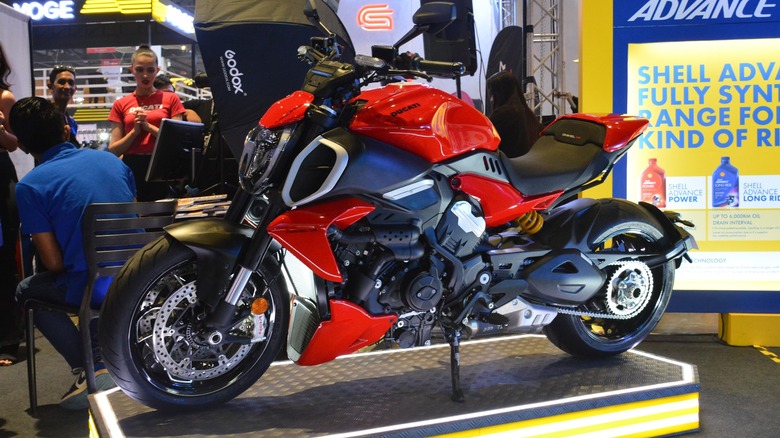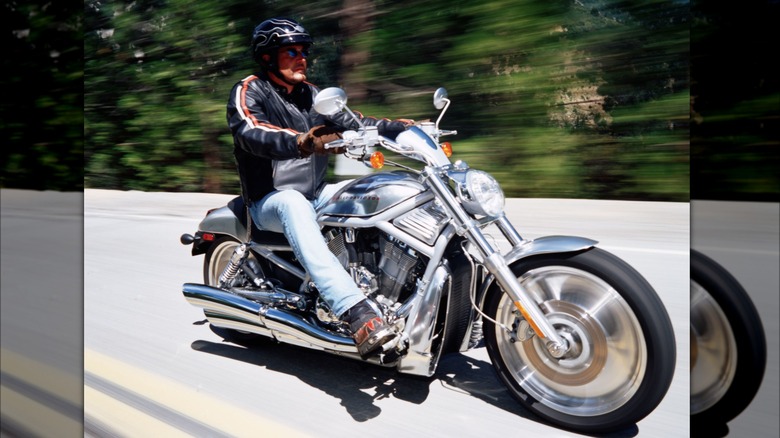11 Alternatives To The Harley-Davidson V-Rod
Harley-Davidson's history shows distinctly it likes to make air-cooled v-twin cruisers often dripping with chrome. It's also shown that outside the box thinking is possible and has been almost from the start. Looking through Harley archives, you will find a scooter, a boxer engine, dirt bikes, golf carts, and even a snowmobile. It is just that its bread and butter is the classic American v-twin cruiser, and that will most likely never change. Those classic cruisers don't have to be the only thing from Harley.
The 2002 Harley-Davidson lineup introduced a very different motorcycle to us. The V-Rod came with an all-new water-cooled DOHC engine built with engineering help from Porsche, a more aggressive and sporty posture, and a whole lot of power. With 115 horsepower on tap and a wide piece of rubber out back, the V-Rod is a bike that wants to be driven.
The disrupting nature of the V-Rod is one of its drawbacks. "Real" Harley riders turn their nose up at it while other riders might tell you if they had to ride a Harley, then it must be the V-Rod. Despite the minor controversy, It stuck around in Harley's lineup until 2017, thumbing its mechanical nose to all the naysayers. While some like the V-Rod but prefer having a new model, the V-Rod is no longer offered. Regardless of why one might seek it, these machines could serve as a V-Rod alternative.
Yamaha Vmax
Management at Harley had a great idea when they put together the V-Rod. A modern and sporty bike built with a sophisticated water-cooled engine rather than a limited air-cooled version will always strike a chord with at least some buyers. Harley managed to strike that chord with the V-Rod. However, Harley did not come up with this idea first. When the V-Rod debuted, Yamaha had already been building its competitor for 17 years.
Yamaha introduced its impressive Vmax in 1985, introducing the world to what many have since called a "muscle bike." There was nothing like it at the time, and people noticed. 120 horsepower came from its liquid-cooled V4 engine with dual overhead cams fed initially by a pair of carburetors and later by fuel injection. Its appearance from the start more closely resembles a cruiser than the Universal Japanese Motorcycles populating the streets at the time, and its side air scoops recall the shaker hoods of late '60s muscle cars. It was a force to be reckoned with upon debut.
The Vmax lasted until 2016. It broke barriers upon introduction but left among a crowded field. The original Vmax and its impressive output showed a new way to do power that the V-Rod later emulated while charging a premium. On the used market, a Vmax from the later years is a great V-Rod alternative that will cost much less and possibly be more trouble-free.
Indian Scout
In the early days of the motorcycle industry, Indian provided a natural alternative, and rivalry, to anything coming from Harley-Davidson. This changed after WWII and Indian went belly up. After a couple of failed revival attempts, the current Indian Motorcycles, owned by Polaris, stands strong and once again offers sound alternatives to the other American purveyor of v-twin motorcycles.
Therefore, one seeking V-Rod pleasure from a dealer without a bar and shield logo will certainly turn to Indian, and the latest Indian Scout is a good choice. The Scout name has a very long history with the company, and the latest iteration was not developed to be a direct competitor. However, if you want a water-cooled bike with a comfortable posture and provides ample power, the Scout might be the one.
The Indian Scout represents a range of models meant for broad appeal. V-Rod riders might be most drawn to the Sport Scout or the 101 Scout as styling for the other models sways closer to the heritage look. Regardless of model, the engine will be a 1250cc water-cooled and fuel-injected v-twin providing 105 horsepower. It's not a direct corollary to a V-Rod, but it gets pretty close and the ride should make all but the pickiest rider happy with a laid back and comfortable ride and plenty of power. With the absence of the V-Rod in Harley's new model lineup, the 101 Scout could serve as a solid stand-in.
Victory Octane
Wanting to break into new markets outside of jet skis and snowmobiles, Polaris embarked upon a path in the '90s leading it to the v-twin cruiser market with a brand of motorcycles called Victory. From 1997 until 2017, Victory produced innovative and forward-thinking cruisers that performed well with solid reliability. Polaris also purchased Indian Motorcycles, eventually closing Victory in favor of the heritage marque.
In the waning days of Victory, it released the Octane. As this was nearing the end of Victory production, the Octane shares much with the Indian Scout, including the engine, gas tank, exhaust pipes, seat, fender, and handlebars. Perhaps the wheels are different. Regardless, the Octane is still a solid machine with edgy and modern looks.
This bike once again sits with a position that mirrors the V-Rod very closely. It provides 100 horsepower from its 1200cc DOHC engine, and belt drive keeps things quiet. It may be a tad bit slower than the V-Rod, but riding it will still be no disappointment. Best of all, while 2016 to 2017 V-Rods are found on Cycle Trader with prices mostly above $10,000, you can find these Victory Octanes for less than $7,000. Having a different badge on the tank is worth that $3,000 savings to someone.
Kawasaki Vulcan S
Kawasaki introduced its Vulcan motorcycle line in 1984 as a Japanese option to the dominant cruisers in the American market at the time, Harley-Davidsons. Vulcans started off small and aimed at the Sportster with a 750cc bike to avoid tariffs of up to 49% that Harley had convinced the Reagan administration to pass to protect it from imported competition.
Once tariffs were lifted, Vulcans began to arrive with increasing engine sizes to the point that Kawasaki made the Vulcan 2000 with a giant 2.0-liter v-twin. Today, Kawasaki has pared down its Vulcan line to four models, all of which are water-cooled cruisers. The smallest of them, the Vulcan S, is a unique machine as it is a cruiser but is powered by a parallel-twin instead of a traditional v-twin.
With its 650cc parallel-twin engine, the Vulcan S is not really a direct competitor to the V-Rod, but it could be an alternative. It has the style and form of a sport cruiser similar to the V-Rod, but it is smaller and less powerful while also having a much lower cost. With a base model's base price coming in at $7,399, it is about half of the cost of the last V-Rod when it was still available, and that does not take inflation into account. Basically, the Vulcan S is for the rider who really likes the V-Rod, wants a new bike, but has a limited budget under $10,000. Nonetheless, that buyer will still get a great bike.
BMW R18
Generally speaking, it may be safe to assume a V-Rod buyer is comfortable buying a more sophisticated bike loaded with the latest technology that still retains some classic styling. The V-Rod does have a sophisticated water-cooled v-twin and a merging of classic and modern looks. One interesting alternate choice that comes as sophisticated as anything else on the market, but retains classic lines and heritage details in a big way is the BMW R18, a surprise V-Rod alternative.
Truthfully, the BMW is a more reasonable choice than it might first appear. It has a twin engine, although it is an air-cooled boxer. It retains classic styling to its core as it emulates BMW models from the 1930s — it shares many of its lines with the pre-war BMW R5, one of the coolest looking bikes from the company.
As a Euro cruiser motorcycle, the R18 is an easy choice for most riders. Although the basic boxer configuration is very old, this 1800cc twin is a sophisticated machine with full computer controls and excellent efficiency. As a V-Rod alternative, it is certainly not a direct parallel, but something new and adventurous that can provide a similar riding experience. Since the V-Rod is no longer made, here is a different kind of machine that will comfortably take you anywhere for less than $20,000. It is worth a test ride for sure.
Arch KRGT-1
There is no denying the V-Rod is an attractive machine dripping with cool, especially with a special edition package applied. Regardless, some riders want a bike so unique that nobody can forget it. Furthermore, that concept can be taken a step further in that you may want a bike that is built so uniquely that nobody on Earth has one just like it. This might seem a bit lofty and unreasonable, but nobody said that Arch, the motorcycle builder founded by actor Keanu Reeves, is supposed to be reasonable.
Reeves' company builds air-cooled v-twin sport bikes assembled in a completely bespoke fashion for each individual buyer. Arch currently offers three models, all powered by an S&S air-cooled v-twin engine. The 1S and Method143 are both inspired by track bikes and have an aggressive riding posture mated to incredibly powerful engines while the KRGT-1 is a performance cruiser.
Reeves wanted an American-style cruiser that could actually handle. Unlike most American cruisers, it is an exercise in minimalism — full of spaces that show you it only has what it needs and nothing more. IT is also not sold in dealers, you order one and work with the build team to have it built to your specific specifications. The cost for this is north of $80,000, so it still is not a practical V-Rod alternative for many. But for the lucky few who could buy one, there would be no reason to ever ride a Harley again.
Suzuki Boulevard M109R
Like its domestic competitors, Suzuki worked to break into the American cruiser market with cleverly engineered and classically styled motorcycles that appeal to American buyers. It started with the 700cc Intruder in 1985, followed by a large 1400cc Intruder designed with chopper styling cues from fender to fender. Eventually, Suzuki renamed its cruisers and placed all of them under the Boulevard umbrella in 2005.
In 2006, Suzuki brought us the Boulevard M109R muscle bike. With a fuel-injected and water-cooled 1.8-liter V-twin and 123 horsepower, it has torque for days and won't quit as long as you keep pushing it. Furthermore, the styling and body panels blend the cruiser aesthetic with modern style, resulting in an incredibly attractive machine. Furthermore, it is a bike made to ride. It lacks storage or any rack for strapping bags on – it is meant to be ridden.
You won't find anything saying Suzuki built this as V-Rod competition, but it does fit the bill. Also, Suzuki has long been known for building highly reliable machines. Best of all, Suzuki still builds it, giving it all the advantages over a discontinued model.
Buell Super Cruiser
After leading Harley-Davidson in research and development, Erik Buell stepped out to create his own motorcycle company. Eventually, Harley purchased controlling shares in the company and kept it as a street bike companion to the big cruisers. But in 2009, Harley closed Buell and ended production completely.
Now some 15 years after Buell Motorcycles was dissolved, Erik Buell is back with a whole new line of motorcycles once again bearing his name. The new Buell motorcycle no longer has any connection to Harley-Davidson, and Erik Buell has free reign to build whatever he wants. This time around, that includes a v-twin cruiser.
The new Buell company is building its own engines. They have stuck with a v-twin, but this one is liquid-cooled with overhead cams. Placed in the new Buell Super Cruiser, it provides 175 horsepower of motivation in what looks like an otherwise austere and lightweight — a scant 450 pounds — package. It is certainly a cruiser, but is still distinctly Buell, especially with its distinctive Zero Torsional Load front brake. As an alternative to a V-Rod, the Buell will be significantly faster and its suspension and low weight will make it much more fun to toss around the back roads. However, it will cost you. The Super Cruiser is available for pre-order for a Fall 2025 delivery for $25,900.
Honda Magna
Honda's first foray into the American cruiser market began earlier than most. In 1982, it introduced the VF 750 C Magna, a mid-sized street bike emulating the style of the contemporary Harley-Davidson Sportster. However, the Honda differentiated itself with a vastly different power source. Instead of an archaic air-cooled v-twin, the new Magna came with a liquid-cooled V4 and four valves-per-cylinder that was anything but archaic at the time. Furthermore, Honda introduced a model in 1983 with an 1100cc V4 that avoided tariffs by being built in Ohio.
Fast forward to the turn of the millennium, and you can see that the Magna had developed and evolved into a stylish cruiser with distinctive styling that continued in the tradition of the American cruiser. Still with a V4 and still just a 750cc, owners of the Magna knew their bike was not the biggest or fastest, but was endlessly reliable and offered a comfortable ride with excellent ergonomics.
To be clear, the Magna is not a direct V-Rod alternative, especially since they stopped production 20 years ago. What the Magna represents is a budget alternative for fans of the V-Rod who cannot cough up ten grand or more for a Harley. For just a few grand, a nice reliable Honda can be yours. And if you can find one, the late '80s Super Magna looks the part of a muscle bike even with a bit less power.
Triumph Rocket 3 GT
British manufacturer Triumph has given us many stylish and iconic motorcycles throughout its tumultuous history, including a period from 1983 to 1988 without a new Triumph model. But in 1990, Triumph was reborn and has continued to produce new icons and set new benchmarks with each generation. Currently, the Triumph model that sets the benchmark for all others is called the Rocket 3 GT, and its specifications are impressive.
Triumph calls it a muscle roadster, and that feels appropriate as it is propelled by a giant 2.5-liter triple, equivalent to squeezing three 800cc singles together in one bike. With 180 horsepower on tap, the Rocket 3 lives up to its name, and the only way to get more torque is to build a custom motorcycle. But to further sweeten the pot, it is a gorgeous machine. With its dual headlights, cropped rear tail, and giant rear tire affixed to a single swingarm, there doesn't seem to be a bad angle for it.
While the Rocket 3 GT is not a v-twin cruiser, it is all muscle. It looks as aggressive as its giant triple performs while offering all the modern technological amenities you expect from a premium bike. While the price tips the scales at $25,000, the Rocket 3 is not so much an alternative to the V-Rod as it is simply a better choice.
Ducati Diavel V4
Ducati is often the first place to turn for ultimate in performance on two wheels. With its long history of building sophisticated and powerful v-twin engines, Ducati is synonymous with speed and power. However, the Italian bike builder is not a one trick pony and has varied its production periodically. At present, Ducati offers the Diavel V4, its only cruiser model in the lineup.
To call the Diavel a cruiser might be a bit of a misnomer. To call it a muscle cruiser might be more accurate, but the Diavel defies categorization. It is a cruiser only in that Ducati built it to be a pleasurable way to get around with a comfortable ride. It also made it possible to have plenty of fun by providing a water-cooled V4 with 168 horsepower serving as a stressed member of the monocoque chassis, keeping weight to a minimum. This gives the rider the option for a leisurely cruise or to tear down the highway like a crazed banshee.
Further separating the Diavel from most cruisers is its styling. It comes with modern looks, updated in 2023, with little similarity to any American v-twin. So as an alternative to a V-Rod, the Diavel is questionable, especially for any American cruiser die-hards. But for anyone who is open to exploring different roads, the Diavel could be a great alternative, but only if you are comfortable paying nearly $30,000 for your bike.
Why not just buy a V-Rod?
While Harley-Davidson's V-Rod was one of its most powerful bikes at one time and remains popular among a certain segment of the Harley fanbase, it was discontinued. Therefore, those seeking a new model are out of luck. Furthermore, cruisers tend to retain more value than other types of motorcycles, and Harleys hold their value better overall. This might be good news for new Harley owners, but it makes it more expensive to get into a used model. Compounding this is the fact that Harleys tend to be expensive in the first place, with retail prices running much higher than equivalent models from other brands.
For anyone who likes the V-Rod, is okay with buying used, and can afford what is offered in the market right now, they should buy a V-Rod. It's a great bike. Others might be considering a V-Rod but have one reason or another why it just does not fit their needs exactly at the moment. It is for them that we present this list of V-Rod alternatives. Keep in mind that these are all just recommendations that should be taken with a grain of salt, and that you should always do plenty of your own research before making any significant purchase. But most of all, ride safely and have fun.
